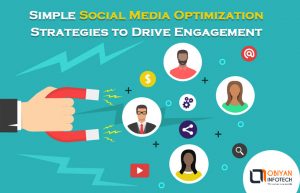In the modern era of technology, social media has emerged as a potent tool for businesses to engage with their target audience and advertise their products and services effectively. However, in this highly competitive space, merely having a presence on social media is not enough to make a significant impact.
To stand out, businesses must strategically align their design and content marketing efforts. Here we will explore the importance of design in social media marketing and provide actionable tips on how to effectively integrate design and content marketing strategies.
The Power of Visual Content
Visual content holds immense power in capturing the attention of social media users. Studies have shown that posts with images or videos receive higher engagement rates than text-only posts. Therefore, businesses must invest in high-quality, visually appealing content that resonates with their target audience.
Understanding Your Target Audience
To design content that resonates with your audience, it is crucial to understand their preferences, interests, and pain points. Conduct market research and use social media analytics to gather insights into the demographics and behaviours of your followers. Armed with this knowledge, you can tailor your design elements to align with your audience’s tastes.
Consistency in Visual Branding
Consistency in visual branding is essential for creating a strong brand identity on social media. Use a consistent colour scheme, typography, and brand logo across all your social media platforms. This will not only make your brand recognizable but also foster trust and credibility among your followers.
Creating Eye-Catching Graphics
Graphics are a powerful way to convey messages and emotions quickly. Invest in creating eye-catching graphics that complement your content marketing strategy. Whether it’s infographics, quote cards, or attention-grabbing images, visually compelling graphics can significantly enhance your social media presence.
Video Content Strategy
Videos have become a dominant form of content on social media. Develop a video content strategy that aligns with your content marketing goals. Engaging video content, such as product demos, behind-the-scenes glimpses, or customer testimonials, can foster stronger connections with your audience.
Responsive Design for Mobile Users
A considerable portion of social media users accesses platforms through their mobile devices. Ensure that your design is responsive and optimized for mobile viewing. Mobile-friendly content is more likely to be shared and engaged with, increasing your brand’s visibility.
Incorporating Calls-to-Action
A well-designed call-to-action (CTA) can drive user engagement and conversions. Whether it’s prompting users to like, share, comment, or visit your website, strategically incorporate CTAs within your design to guide your audience’s actions.
A/B Testing and Iteration
Incorporate A/B testing into your design and content marketing strategy. Experiment with different design elements, such as colours, visuals, and CTAs, to identify what resonates best with your audience. Continuously iterate and optimize your designs based on the results of these tests.
Utilizing Social Media Templates
Social media templates can be a valuable asset for maintaining consistency in design across your posts. Create templates for different types of content, such as announcements, promotions, or educational posts. These templates will not only save time but also ensure a cohesive look and feel throughout your social media profiles.
Emphasizing Storytelling
Effective social media design should go beyond aesthetics; it should tell a compelling story. Incorporate storytelling elements into your visual content to evoke emotions and create a lasting impact on your audience. Whether it’s through relatable characters, customer success stories, or a brand journey, storytelling can make your content more memorable.
Monitoring and Responding to Engagement
Monitoring your social media engagement is crucial to understand how your design and content resonate with your audience. Pay attention to comments, shares, and reactions, and respond to them promptly. Engaging with your audience humanizes your brand and encourages loyalty.
Collaboration with Influencers
Influencers can help amplify your social media presence by showcasing your products or services to their followers. Collaborate with influencers whose audience aligns with your target demographic. Provide them with high-quality visuals that match their style while maintaining your brand identity.
Incorporating User-Generated Content
User-generated content (UGC) is a powerful way to foster authenticity and trust. Encourage your followers to create content featuring your brand and share it on social media. Repost and highlight UGC to showcase the positive experiences of your customers.
Analysing and Adapting to Trends
Social media trends are constantly evolving. Stay updated on the latest design and content marketing trends in your industry. Experiment with incorporating popular trends into your strategy while staying true to your brand identity.
Social Media Advertising Design
Paid social media advertising allows you to reach a wider audience. When designing ads, ensure that the visuals align with the ad’s objective and target audience. Use compelling visuals that grab attention and motivate users to take action.
Measuring ROI and Refining Strategy
Continuously measure the return on investment (ROI) of your social media efforts. Analyse metrics such as click-through rates, conversion rates, and engagement to gauge the effectiveness of your design and content marketing strategy. Use the data to refine your approach and focus on what works best for your brand.
Lastly, we can say that, integrating design with content marketing on social media is essential for building a strong and influential brand presence. By understanding your audience, maintaining consistency, and utilizing storytelling techniques, you can create visually appealing content that resonates with your followers.
Embrace experimentation and continuously optimize your strategy based on data-driven insights. Social media’s vast potential for connecting with your audience awaits – leverage design to unlock new levels of engagement and success.
You Can Read Also:
How to Drive Growth by Maximizing Customer Value in Digital Marketing
The Most Comprehensive Guide on What is SEO and How does it Work?



